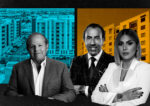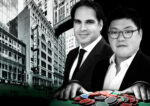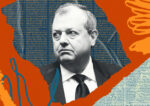Trending
Plotting the future of Miami’s skyline
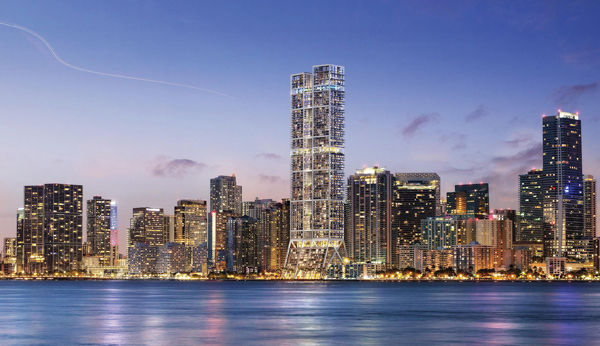
With more than four years’ supply of luxury condos for sale, it’s plain to most people in the real estate community that the market does not need any more condo projects. Developers have no choice but to hope their existing projects inch closer to selling out while they toil away on plans designed for a better market in the future. Many are now plotting the next batch of supertall towers to grace Miami’s skyline by hiring top architects and attorneys, surveying industry leaders on their plans and assembling their sales and marketing teams, insiders told The Real Deal. They just have to wait out the cycle’s end before they launch.
In one example, Carlos Ott — a Uruguayan architect who worked on Echo Brickell, Jade Beach and Jade Ocean — has been hired along with Miami-based Sieger Suarez Architects to design a luxury condo tower at 300 Biscayne Boulevard, Property Markets Group (PMG) principal Ryan Shear said.
The skyscraper, designed as a stack of glass cubes, would be the tallest in Miami at 1,049 feet, renderings show. Plans for the property, which the company acquired for $80 million in 2014, include a 94-story condominium with 640 units and a luxury hotel with a wellness-focused spa.
The project could be ready to launch in as little as two months, according to Shear — but that’s not happening. “We need a good cycle to launch projects like that. The worst thing in my opinion you could do is try to swim upstream,” Shear said, adding that he expects developers to start launching new developments again by 2019 or 2020.
The development is one of many scattered throughout Miami that won’t make it in this real estate cycle, but is poised to change the city’s landscape during the next one.
Another such project is The Towers by Foster + Partners, a pair of connected high rises planned for 1201 Brickell Bay Drive, about a mile south of 300 Biscayne, just over the Brickell Bridge. The developers — Florida East Coast Realty, Corigin Real Estate Group and McCourt Global Properties — met with top brokers last year seeking feedback on the plans, which now call for 660 residential units.
Sources say the waterfront development will be built as condos, but a launch date hasn’t been determined.
The Related Group, too, is expected to relaunch at least two large-scale condo projects in Miami during the next cycle: 444 Brickell Avenue and 1400 Biscayne Boulevard. Both are luxury condos that will be built in three phases. The only certainty regarding a launch date for either project is that now is not the time.
“We are looking for signs. Right now it’s not the right time to launch,” Carlos Rosso, president of the condominium division, said.
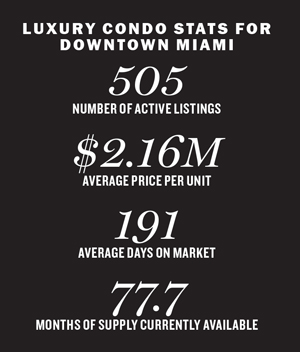 Slow sales led the developer to cancel its Auberge Residences & Spa Miami project planned for the site at 1400 Biscayne — shutting down the 290-unit tower’s sales center and returning buyers’ deposits by early 2017 — less than a year after launching. That cancellation in particular was a key indicator that the market had reached a critical point in the cycle, insiders said.
Slow sales led the developer to cancel its Auberge Residences & Spa Miami project planned for the site at 1400 Biscayne — shutting down the 290-unit tower’s sales center and returning buyers’ deposits by early 2017 — less than a year after launching. That cancellation in particular was a key indicator that the market had reached a critical point in the cycle, insiders said.
Devil-may-care developers
While some are waiting to start projects two to three years in the future, there are a handful of others fearlessly forging ahead today — though it should be noted that in those cases, ample coffers certainly helped. In March, two new projects launched sales. OKO Group, led by Vlad Doronin, began sales for Una, a 47-story, 135-unit luxury condo tower at 175 Southeast 25th Road, with an architect and sales team in place. The developer, who has the financial backing to move forward, is planning to complete the building by 2021. That’s when some say the next cycle will begin.
Over on Fisher Island, developer Heinrich von Hanau just launched sales for a project he already started building. Palazzo Della Luna, a 10-story, 50-unit building, is expected to open next summer.
Some of the most high-profile projects where sales and construction are underway may continue to sell and build into the next cycle — a costly move that could pay off if their completions are timed correctly. They include One River Point along the Miami River and the Estates at Acqualina in Sunny Isles Beach.
KAR Properties’ Shahab Karmely launched One River Point, a twin-tower, 60-story, 386-unit luxury condo development connected by a “Sky Club,” in 2015 — at the same time that the Estates at Acqualina launched. Sales have been slow at One River Point, which also faces challenges by having a not-so-concrete timeline. “Our sales are chugging along,” Karmely said. But “they’re not as strong as I would like them to be.”
Jay Parker, CEO of Douglas Elliman Florida, acknowledged that the lack of a timeline is “a very significant concern” among buyers. “People want to know how long it’s going to take. That’s why you see a lot of developers taking a lot of risk,” he added.
Site work at One River Point is now underway, and the developer expects to pour the foundation by the end of 2018. Despite launching later in the cycle, Karmely, too, has deep pockets he can rely on. His silent partner is Daniel Loeb, the billionaire investor who runs Third Point, one of the world’s most prominent activist hedge funds.
“You can only wait so long before you say, ‘Oh, shit. I waited too long.’ In life, you’ve got to jump in and swim,” Karmely said.
Others are making conservative moves aimed at mitigating any potential losses.
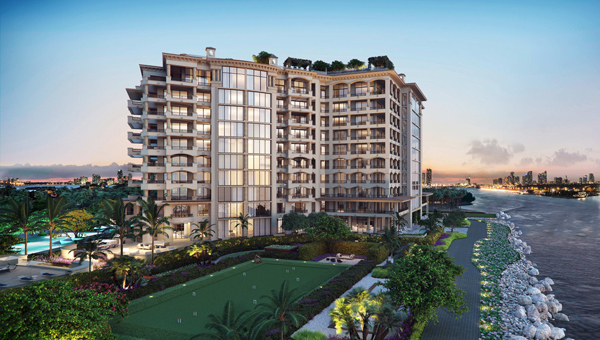
Palazzo Della Luna by Heinrich von Hanau
“The best approach a developer could take is [to] look back at history,” said Peter Zalewski, founder of CraneSpotters and Condo Vultures Realty, databases that track the preconstruction condo market and distressed opportunities, respectively. He pointed to the St. Regis Bal Harbour as an example of a profitable slow-and-steady approach. “They built very slowly and were able to deliver right as the market was returning.”
At Brickell City Centre, Swire Properties still has about 150 unsold condos at Reach and Rise and won’t launch sales for phase two until those units are sold.
Nevertheless, Swire is preparing for the second phase, which is slated to be a vertically stacked equivalent of phase one. The development firm also recently announced a partnership with Colombian businessman Carlos Mattos to build a residential project on a site immediately north and west of Brickell City Centre. Development marketers are eager to bid on the new business.
Securing new sites
As a cycle is ending, developers typically focus on looking for land they can develop in the next cycle while getting approvals for plans on the sites they already own. But, given the specifics of today’s market, there are a few flaws in that plan.
Inigo Ardid, co-president of Key International, said land prices are still too high for such moves. “The value of land is how much you can build on it. If the market’s not there, it should get a corresponding discount,” he said. “Right now, it’s not.”
Ardid — whose company recently delivered the 389-unit 1010 Brickell and will soon complete The Harbour, a 425-unit project in North Miami Beach — is looking to buy land, “but it’s going to take a little bit of time for the market to come back. People have to price land correctly,” he said.
PMG recently closed on a site at 400 Biscayne Boulevard, where the developer will build apartments and condos. That deal, a $55 million purchase, was about two years in the making. “Pricing is tough right now,” PMG’s Shear said, adding that there’s a big gap between sellers’ perceptions and the reality of today’s market.
Shear points to a 26,600-square-foot development site at 200 Southwest Eighth Street in Brickell as an example. The corner property recently hit the market for about $19.4 million. It could be built into a 122-unit residential tower or a 244-key hotel, plus retail, according to Alfonso Jaramillo of Fortune International Realty, who is marketing the property. PMG looked at the site, but Shear said it was too expensive.
Prospecting continues nonetheless. Related has a couple of sites it’s eyeing for development, Rosso said, declining to identify where they’re located. Louis Birdman of One Thousand Museum said he and his partners own a site in Broward County that they’re considering for a project, but he did not disclose more information.
“If I were developing in Miami, I would think long and hard about launching now,” said Elliman’s Parker.
A cloudy ending to the cycle
The end of the cycle isn’t such a terrible place to be today compared to the crash-and-burn ending in 2008. Some hard-earned lessons from that time ensured that today, fewer buyers have walked away from their units — the 50 percent deposit structure is largely responsible for that — and fewer projects have been canceled.
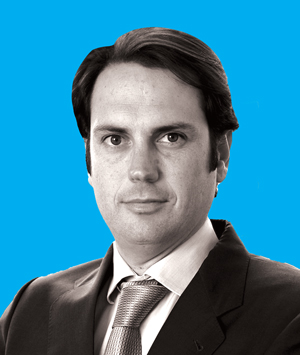
Inigo Ardid
Shear believes the cycle ended a year ago, when sales slowed dramatically in South Florida. But now, he said, “we’re in a gap period, closer to the next cycle than we are to the end of this cycle.”
He’ll begin closings at Muse Residences in April with more than 80 percent sold. The luxury condo tower in Sunny Isles Beach has about 12 remaining units from a total of 64, he said. But last year, PMG sold only eight units at Muse. Most sold in 2015, when pre-construction condo sales in Miami peaked.
Pricing hit a high in 2016, which certainly didn’t help with sales, brokers said. While developers are hoping 2017 was the worst of it, that’s probably not the case. Once construction is for the most part over, developers will be stuck with unsold inventory and the carrying costs that come with those units. Buyers (including a number of investors) will also try to flip their units, flooding the market with even more inventory, Zalewski said.
“When the last crane comes down, that’s when the game is on because the clock is ticking,” he added.
Related, which took the number one spot in TRD’s 2017 ranking of top South Florida condo developers, is delivering nine condo buildings this year and another four next year. Most, including Hyde Midtown, SLS Lux and the Paraiso complex in Edgewater, are nearly sold out, the company said.
Timing the market
If developers are getting their next-cycle plans together now, the question is, when should they pounce?
Before a new cycle begins, a few things have to happen. Rents will fall thanks to an oversupply of condos on the rental market. Resale inventory needs to decline — quickly — so that demand and prices will rise.
“This is a hard market to predict. I don’t think anyone in their right mind thought the market was going to come back as strong as it did as long as it did,” Ardid said.
International Sales Group tracks pre-construction sales of projects east of I-95 in Miami-Dade and Broward counties, and found that of all the new inventory put on the market since 2012, 83 percent has been sold or pre-sold. ISG principal Craig Studnicky is especially optimistic, predicting that most of the remaining inventory will be absorbed this year, giving birth to the next cycle.
However, his prediction seems extremely unlikely, if not impossible — a recent report found that Miami-Dade has four years of existing luxury condo inventory. And a CraneSpotters analysis of new condo sales finds that there’s more than six years’ of supply in downtown Miami. In the county, nearly 2,800 units asking at least $1 million are on the market, according to Condo Vultures Realty. In 2017, 681 luxury units sold in the county, meaning an absorption rate of about 57 units a month, according to the Condo Vultures report. That’s not including the pipeline of new development.
“This is really like what 2011 was. It was pretty obvious we were nearing the end of selling the remaining inventory from the financial crisis of 2008, 2009,” Studnicky said.
KAR Properties’ Karmely doesn’t believe the market will come back as strong as it did at the start of this cycle. “Do I think it’s going to take longer for projects launched in the last two years to sell out? Yes, of course,” he said.
Once the demand is back and developers determine that they can sell new construction at a roughly 35 percent premium, they’ll launch new projects, he said.
Zalewski, who recently joined a private equity firm, Brickell Ventures, which is focused on buying bulk condo deals at discounts, expects the next cycle won’t begin until late 2021 or 2022.
Everyone — developers, brokers and agents — are still optimistic, hoping the market will turn around, he added.
At the same time, they’re getting their approvals and teams in place to be in the right position “once we get out of the correction,” Zalewski said, referring to projects like Magic City and Design Place in Little Haiti. “They’re in early for the next cycle but way too late for this cycle.”

